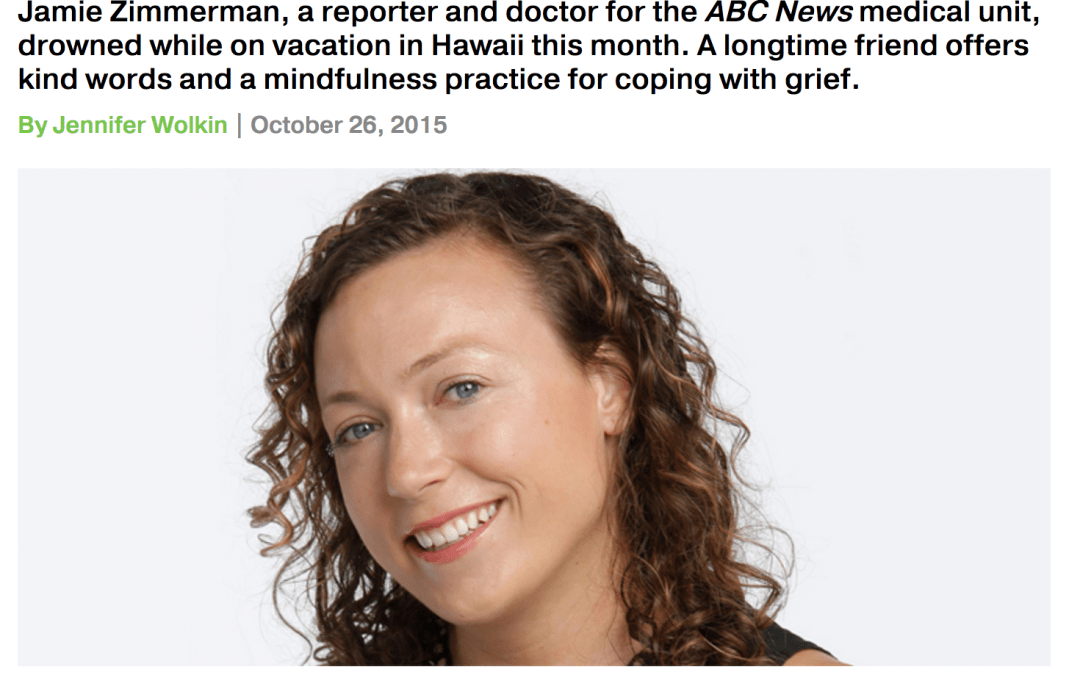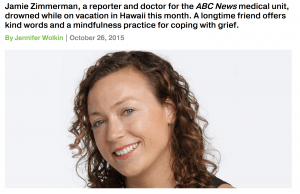
by Jennifer Wolkin | Jun 15, 2016 | Blog, PTSD, Relationships, Wellness
In honor of PTSD Awareness Month, and in response to the tragedy in Orlando, I offer five ways to help us help our children and ourselves in times of trauma.

- Give Yourself Permission to Feel Many Emotions at Different Times:
One of the core concepts of mindfulness meditation is the idea of having an attitude of non-judgment of, and openness towards, current experiences. After a tragedy, it is natural to react with shock, anger, numbness, sadness, grief, confusion, and even denial. Most often, grieving is not a linear process and you might experience yourself fluctuating between different feelings at different times, on different days and during different weeks. It is okay. Allow yourself to feel what you feel with as little judgment as possible.
- Take Care of Yourself, Then Take Care of Others:
This is true on any given day, but most importantly at a time like this. If you are anxious and your symptoms continue to persist, please reach out for support/professional guidance. More than ever, make a point to engage in your usual routine. Eat well and sleep well. Engage in healthy coping strategies (breath from your diaphragm, take a bath, journal, watch a comedy, create your own safe space and let yourself cry). Managing your own stress is a precursor to helping your children manage theirs.
- Create a Sense of Safety:
For most children, their parents symbolize safety. In times of doubt, children look to their primary attachment figures to cultivate a safe space. Let your children know you are available if they have questions and actively make yourselves available. Children don’t yet have the same cognitive tools needed to cope. Model resilience in the face of hardship without denying that hardship.
- Recognize, Be Real, But Reassure:
It is important to recognize signs of your children’s distress. Sometimes it is not obvious, as fear and anxiety might manifest as physical symptoms (stomach aches and headaches) and/or insomnia (and other sleep difficulties). Children, especially teens, might isolate and/or withdraw. Recognize the pain. Then, it is important to be real with your children. Limited media exposure is a crucial element, but on the flipside, children need to know what happened. If your children do not approach you, take the time to find out what kinds of questions they are having and what kinds of feelings they are experiencing. Use discretion (talk to them in an age-appropriate way) and be honest about what is happening; it is important not to deny the events. After honest, but age-appropriate and discrete discussion, reassure your children’s sense of safety. At this juncture, they are internalizing and probably deeply personalizing the events, wondering “when will something happen to ME.” Reassure through returning to normal routine and sending messages of safety overall. Keep life feeling as safe and predictable as possible under the circumstances.
- Reassess and Regroup:
Different people, of different ages, express trauma differently, at different times. The reaction to trauma will vary greatly. One thing, however, is for sure: The effects of trauma don’t go away easily. They might remit or decrease in severity, but they usually ebb and flow for a very long time.Healing is possible and there is hope amidst this gripping grief. As children develop they will adopt more evolved coping skills in order to adapt, and ideally the appropriate acute treatment will serve as a tool to cultivate increased resilience as time goes on. Yet, continue to reassess and regroup. It is important to continue to check in with yourself and your children if symptoms reemerge, or if other traumatic circumstances arise.
*If you need a referral to a trauma specialist, please contact me at DrWolkin@BrainCurves.com.
To Healing,
Jennifer Wolkin, PhD

by Jennifer Wolkin | Oct 26, 2015 | Relationships
This post originally appeared on Mindful.org

The other week, I lost a dear friend and colleague, Jamie Zimmerman. A physician, meditation teacher, and author, Jamie lectured internationally on “meditation medicine” and living your calling. She was passionate about global health and believed that healing happens from the inside out. A medical journalist at ABC News, she loved spending time in nature, exploring museums, yoga classes, cafes, and live music. She died as she lived—taking the time to connect to nature and herself in Hawaii, where she was taking a few days for vacation before she was going to speak at a conference.
Jamie’s death is a profound loss to so many people, and many of us grapple with understanding how to grieve. Her death was sudden and shocking, and in trying to make sense of something so seemingly senseless, I found myself remembering one of our last conversations. Jamie and I spoke about the vast potential of maintaining a beginner’s mind and that the essence of mindfulness is remembering this idea when we are faced with something we think we already know. Dear Jamie, all of us who were, and continue to be, touched by your work are forever mindful of you. As we struggle with grief, we will try to do what you would have sought to do with grace and wisdom—bring a mindful perspective to all we are now experiencing.
I offer here five ways to grieve mindfully, but first, I want to touch upon a question I’m asked often as a psychologist. What IS grief? Psychologically speaking, according to Dr. Kubler-Ross (1969), grief is an emotional response to loss. This emotional response is conceptualized as a non-linear expression of different stages of feeling states including denial, anger, bargaining, depression, and acceptance (aka: “dabda”). Biologically speaking, grief is a homeostatic process, a journey that our mind, brain, and body need to engage in to best recover from the trauma of a loss. This is an evolutionary need, since attachment and connection is embedded within our limbic circuitry. Yes, whether we are conscious of it or not, or like it or not, relationships deeply imprint upon our neuronal selves.
Grief is not, by any means, a one-size-fits-all kind of process.
Second, I want to note what grief is not. Grief is not, by any means, a one-size-fits-all kind of process. In fact, it is a uniquely individual process that often feels amorphous and difficult to capture with words. When it comes to grief, there is no “normal” or typical way to “do it.” Despite what some believe, in my opinion, there is no “normal” time period allotted for grief.
It takes a boat load of self-compassion to allow oneself to feel whatever it is you are feeling at any given time, without judgment, without comparison relative to another’s explicit portrayal of their own process. In this way, to grieve is to be mindful of our thoughts and feelings.
Finally, while there is no one “right” way to grieve, to actually grieve is essential for our ability to employ our human capacity to find a renewed sense of meaning. Grief elicits resilience. The capacity to continue to hold a loved one in our heart/mind while still forging forward with purpose and direction.
Five ways to Grieve Mindfully
- Accept your feelings: Allow yourself to feel what you feel at any given moment, with a sense of self-compassion, and without judgment.
- Express your feelings: Just as important as accepting your feelings is expressing them in a way that is helpful to you. Journaling, talking about the experience, scrapbooking, or dancing, for example, are helpful ways to process grief instead of allowing the feelings to stay stuck.
- Reach out: During this time, it is important to reach out in multiple ways. Reach out for guidance from a spiritual counselor or a psychologist. Reach out to share stories of your loved one with others. Reach out to offer support to other grievers. Find a balance between sitting with yourself, and being with others, but ultimately, reach out—don’t isolate.
- Continue to take care of yourself and others. Living life while grieving often feels like scaling a mountain. Grieving takes energy and can often feel draining. As much as possible during this tough time, continue to eat well, exercise, and maintain wellness practices.
- Celebrate your loved one’s life: It is important through the grief process to keep the memory of your loved one alive in some way that both inspires growth, and reflects and honors your unique relationship. This can include donating to a charity, meditating in their honor, and even planting a tree.

by Jennifer Wolkin | Jun 3, 2015 | Brain Health, PTSD, Relationships, Wellness
PTSD AND INTERPERSONAL RELATIONSHIPS
Trauma calls into question the basic foundation of trust in human relationships. Traumatic events not only have effects on the psychological structures of the self, but also on the attachments that link an individual to a greater community. A trauma sufferer is likely to feel as though every relationship is infused with a sense of alienation and disconnection.
The impact of trauma pulls and pulls at the threads of relationships until they tear, or in many cases, disintegrate completely. Sometimes, when I work with the significant other of a trauma sufferer, I am shocked by how far the trauma reaches. It goes inward and outward. Its tentacles have few boundaries.
It is so pervasive, that I often wonder: Is Trauma Contagious?
The literature has demonstrated that PTSD affects family cohesion, parenting satisfaction, romantic partnership, and functioning and emotional security of children. Consequently, poor functioning in these domains is associated with higher rates of divorce and higher occurrences of clinically significant levels of relationship distress in the families of veterans with PTSD than in the families of veterans without PTSD or in the general population.
It probably can’t be overemphasized that poor health outcomes for children (poor development, higher rates of illness, lower academic performance, and cardiovascular disruption) are closely linked to this now-stressful family environment, which is created when the symptoms of PTSD literally intrude upon the family or relationship structure.
PTSD symptoms affect personal relationships indirectly as well. For example, veterans with PTSD are more likely than members of the general population to have clinically significant levels of depression, anxiety, anger, and violence. They are more likely to abuse substances and less likely to hold steady employment. All of these play a role in the breakdown of interpersonal functioning.
The nature of interpersonal problems experienced by combat exposed veterans appears to be correlated with the presence in particular of the avoidance and numbing characteristics of PTSD. In families and relationships, avoidance and numbing may create social isolation, a cold, and unresponsive parenting style, anger, and an absence of emotional warmth.
One of the most consistent relationships observed in trauma research is the inverse relationship between PTSD symptoms and social support (that is, the more social support, the fewer symptoms). The ultimate sad irony is that the people in the world of the trauma survivor are pushed away, though connection is the very thing that is needed.
A supportive response has shown to mitigate the impact of trauma, as the survivor yearns to establish a basic sense of safety and trust. The trauma survivor needs the help of others to rebuild his or her shattered sense of self. Yet, it is a long arduous process during which the survivor cycles between the need for extreme closeness and the need for distance and time to reestablish self-autonomy.
During this process, the toll that these cycles take is hard to gauge. In some cases, members of the support system suffer their own kind of trauma. If merely witnessing the person you love suffering through trauma is not a sort of trauma unto itself, then I don’t know what is.
Recovery for the sufferers and support systems is possible. It is crucial that health professionals understand the impact of PTSD on interpersonal functioning in order to provide the best treatment approaches for the sufferers and their social systems.

This is the third in a series of BrainCurves posts that I will be sharing on the topic of Trauma and PTSD throughout the month of June, National PTSD Awareness Month. Next week I will post about PTSD and Chronic Pain.
To Thriving,
Jennifer Wolkin, PhD

by Jennifer Wolkin | Feb 11, 2015 | Relationships, Wellness

Love is a construct that has been the subject of (and muse for) many artistic, poetic and philosophical gestures since humanity existed, almost like a preoccupation. Yet, what is it about love that elicits such a universal outpouring of sentiment? What IS this love that permeates our heart, minds, and souls-our dreams, our fantasies, our imaginations? Many psychologists and even neuroscientists have posited many different models of what love is and isn’t, which often include our neurochemistry.
Here’s what we know in a nutshell: There is no single definition or way to explain what love is. It’s a visceral emotion that is often unpredictable, overwhelming, and indescribable.
As a psychologist in clinical practice, many of my clients struggle with all different kinds of questions for cupid, but most focus on how to build healthy romantic relationships. A relationship is a coming together to express and engage in love that is shared.
Love, as we know, is mostly intangible, but a relationship is a tangible reflection of the love experienced by two people. If we understand our relationships, we are equipped to notice the nature of our love, and to ascertain whether or not it is serving us. Some relationships are healthy. Others are toxic.
How can we differentiate between a healthy vs. toxic relationship?
There are many differences, but here are some standout clues to better understand the nature of your current relationship or even a future one.
DO YOU AND YOUR PARTNER:
1. Share Dreams or Lose Dreams?
In a healthy relationship, there is support for one’s own dreams, and a union or coming together of shared ones. In a toxic relationship, individual dreams are surrendered and sacrificed for the other. A relationship like this takes and takes, instead of nurturing and cultivating. The toxicity becomes paramount when we can no longer find our own voice.
2. Give to Give or Give to Get?
In a healthy relationship, both people desire to give to one another without any expectation of something in return. Giving is an act of love and an act of trust, as in “I am unconditionally here for you”. In a toxic relationship, giving is usually a way to get something back; there always needs to be a return investment. A price must be made to be cared for, as needs are only met with expectation of reciprocal benefit.
3. Seek To Know or Seek To Change?
In a healthy relationship, there is a desire to truly know one another each day on a more intimate level. Yet, knowing someone deeply, means knowing their vulnerabilities, and in a healthy context, the knowing is paired with wholehearted nonjudgmental acceptance. In a toxic relationship, the goal is not on knowing someone, but on changing someone to conform to a certain projection or a non-existent ideal.
4. Fight to Repair or Fight for Revenge?
Every relationship has some conflict. In fact, conflict if often a sign of passion and commitment as opposed to indifference. In a healthy relationship, conflict is a chance to grow toward one another, and to genuinely create a more effective and loving dyad. In a toxic relationship, conflict is not genuine, nor is it growth oriented. Every conflict becomes an opportunity for payback, revenge, blame, manipulation, control and rejection.
5. Create Privacy or Betray Privacy?
In a healthy relationship, there is a sense of sacredness. There is a “space” that is off limits to anyone else but you two. It is the unspoken nuances of your relationship’s inner life. This includes going that extra mile to protect your partner’s vulnerabilities. In a toxic relationship, nothing feels sacred. Private intimate moments and shared experiences are unprotected and visible to anyone. Weaknesses and vulnerabilities are mockingly exposed to the outside world.
—
Make Valentine’s Day an opportunity to strengthen your healthy relationship, or become more aware of a toxic one. If you aren’t clear, ask a more objective party or even a therapist. Although love can’t truly be defined, keep in mind that relationships are tangible expressions of the quality of love you are experiencing.
What are your thoughts about other ways to differentiate between healthy and toxic relationships? What are your thoughts about love and relationships in general? Look forward to YOUR comments…Let’s start an important conversation!!!
Let’s Thrive,
Dr. Jen







